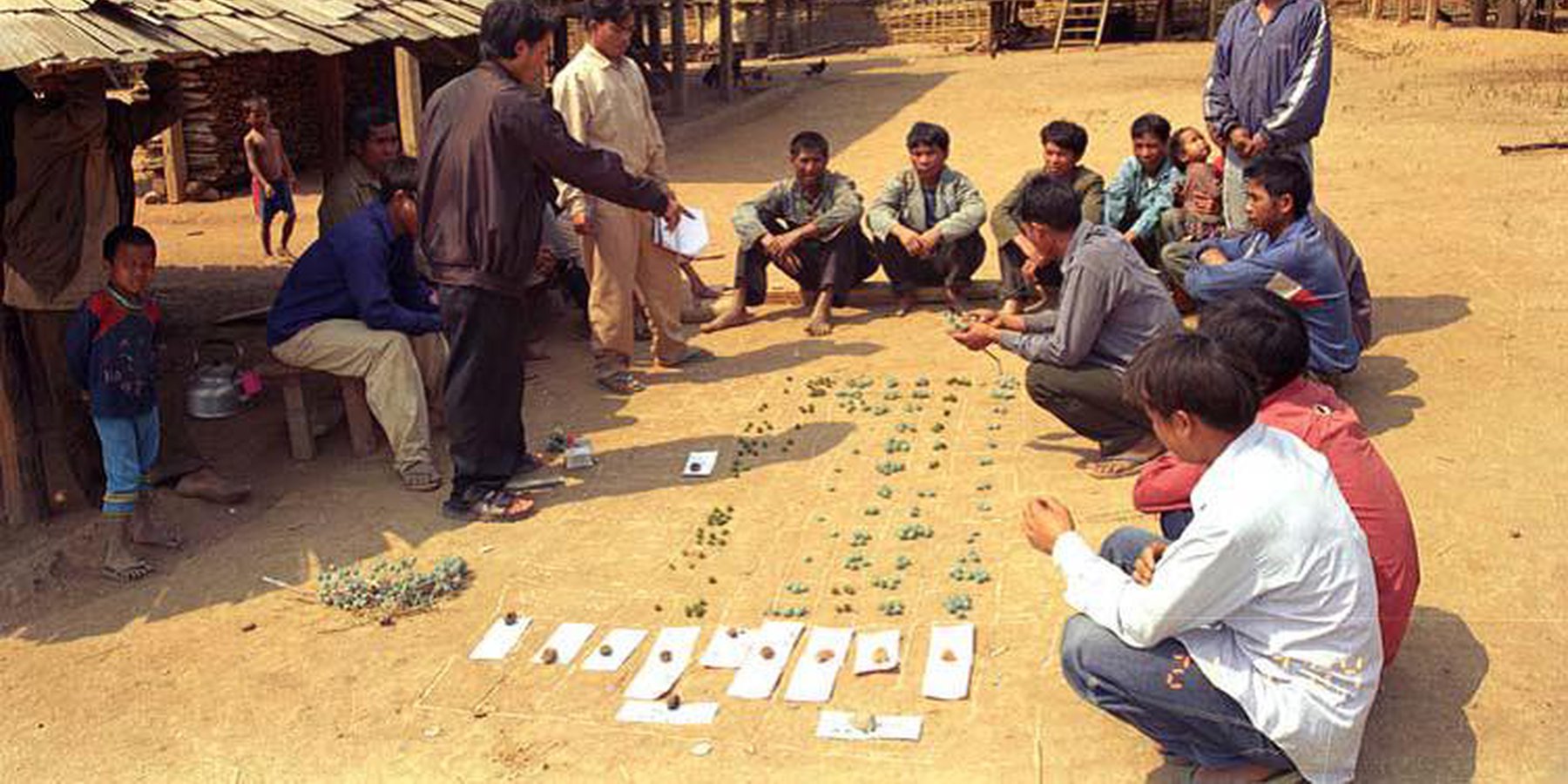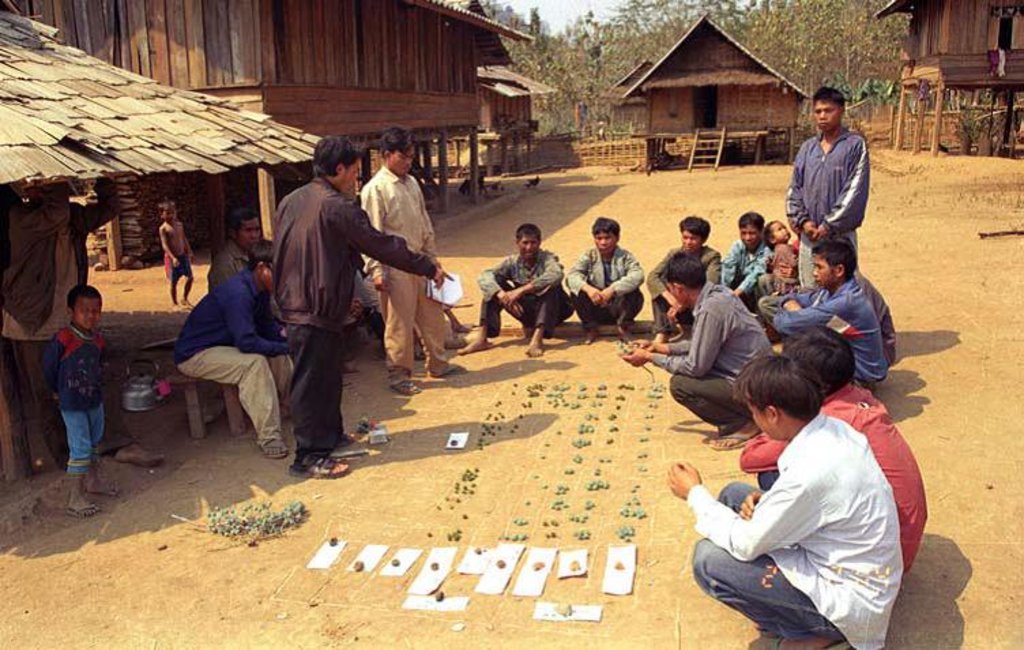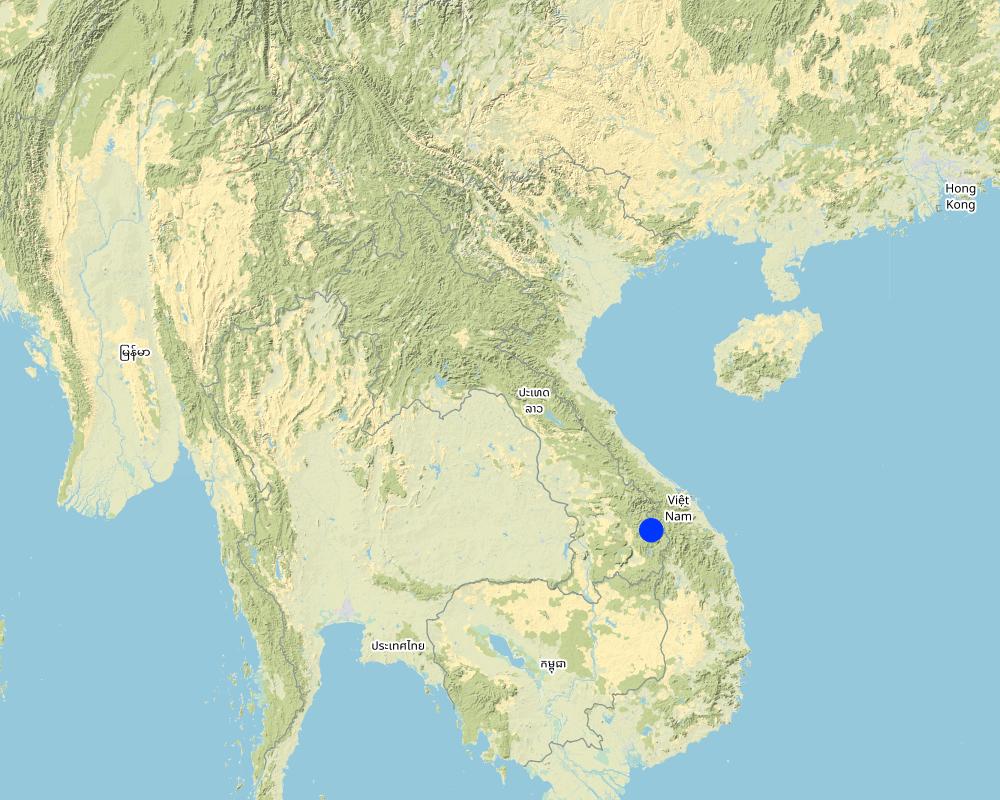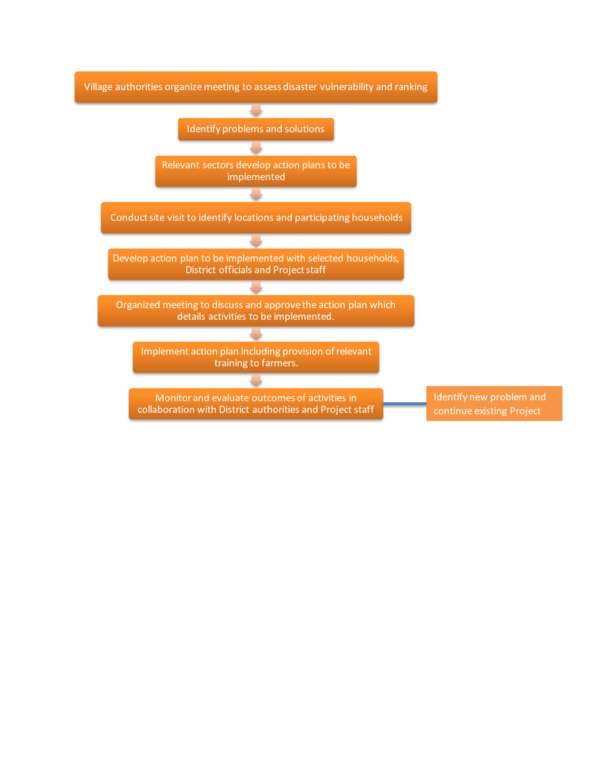Village Capacity and Vulnerability Assessment Project on Disaster Management [老挝人民民主共和国]
- 创建:
- 更新:
- 编制者: Pasalath Khounsy
- 编辑者: Bounthanom Bouahom, viengsavanh phimphachanhvongsod, kang phanvongsa
- 审查者: Nicole Harari, William Critchley, Joana Eichenberger
approaches_3877 - 老挝人民民主共和国
查看章节
全部展开 全部收起1. 一般信息
1.2 参与方法评估和文件编制的资源人员和机构的联系方式
关键资源人员
Project manager:
Phasaveng Phounsy
+856 030 211582
phounsy.phasaveng@careint.org
CARE Office in Saravan
老挝人民民主共和国
有助于对方法进行记录/评估的项目名称(如相关)
Scaling-up SLM practices by smallholder farmers (IFAD)有助于对方法进行记录/评估的机构名称(如相关)
National Agriculture and Forestry Research Institute (NAFRI) - 老挝人民民主共和国1.3 关于使用通过WOCAT记录的数据的条件
(现场)数据是什么时候汇编的?:
25/08/2017
编制者和关键资源人员接受有关使用通过WOCAT记录数据的条件。:
是
2. SLM方法的描述
2.1 该方法的简要说明
The project is aimed at capacity building in disaster emergency response at district and village levels. It has applied a participation approach in planning and implementation. This included the identification of problems, SWOT analyses, implementation, and monitoring.
2.2 该方法的详细说明
该方法的详细说明:
Since 2012, after the Ketsana typhoon hit the southern provinces of Lao PDR, CARE International in Xekong Province has initiatives that address disaster reduction which are funded through various sources. The project is aimed at capacity building in disaster emergency response at district and village levels. DarkCheung district, one of the poorest districts of Xekong province, has established a Disaster Management Unit in five villages. The project was supported by Luxembourg’s Ministry of Foreign Affairs, Debeco, through the European Union. Most of the projects were relatively small and short duration, with approximately 2-3 years of project implementation. In 2017, Care International has also followed up existing activities with support from Debeco which are implemented in the three districts of Kaleum, DarkCheung, and Lamam, covering 16 villages. The aspects of the work that are relevant to the district office of agriculture include Disaster Vulnerability Assessment and Village Capacity Building. The main objectives of the project are to increase capacity in disaster management within local communities; increase food security, gender equality promotion in cooperation with local authorities, and increase awareness about disaster prevention. In principle, the project applied a participatory approach in planning and implementation. This included the identification of problems, SWOT analyses, implementation, and monitoring. The village and district authorities, as well as farmers, have been actively involved in project activities. It should be noted that the district authorities played an active role in community development. However, challenges remain, as Care International in Xekong province developed only short term projects, and this may affect outcomes and continuity of objectives in the future.
2.3 该方法的照片
2.5 采用该方法的国家/地区/地点
国家:
老挝人民民主共和国
区域/州/省:
Sekong Province
有关地点的进一步说明:
Kaluem, Darkchueng and Lamam district
注释:
CARE International Office in Sekong province
Map
×2.6 该方法的开始和终止日期
注明开始年份:
2014
若不知道准确的年份,请注明该方法的大致开始日期。:
不到10年前(最近)
2.7 方法的类型
- 基于项目/方案
2.8 该方法的主要目的/目标
1. Strengthen capacity on disaster management at local levels;
2. Increase food security;
3. Promote gender equality amongst the local authorities; and
4. Increase awareness on disaster prevention.
2.9 推动或妨碍实施本办法所适用的技术的条件
社会/文化/宗教规范和价值观
- 阻碍
Unsafe birth, gender and other issues are sensitive and need careful approach and understanding.
财务资源和服务的可用性/可得性
- 阻碍
机构设置
- 启动
参与者的的协作/协调
- 启动
Good cooperation and participation in implementation of activities amongst the villagers
法律框架(土地使用权、土地和水使用权)
- 启动
政策
- 启动
土地治理(决策、实施和执行)
- 启动
了解SLM,获得技术支持
- 启动
Better coordination and understanding of district officials and village people.
市场(购买投入,销售产品)和价格
- 阻碍
工作量、人力资源可用性
- 启动
3. 相关利益相关者的参与和角色
3.1 该方法涉及的利益相关者及其职责
- 当地土地使用者/当地社区
Villagers or head of household participating in activities
Implementation, labour and material contribution as project needed
- 社区组织
Village authorities
Provide socio-economic information, encourage villagers to participate in the project
- SLM专家/农业顾问
CARE International staff in Xekong Province
- NGO
CARE, Oxfam, Save the Children, French Redcross
- 地方政府
Provincial, district coordinators and technical staffs
Facilitate the coordination and strengthening local authorities and communities
3.2 当地土地使用者/当地社区参与该方法的不同阶段
| 当地土地使用者/当地社区的参与 | 指定参与人员并描述活动 | |
|---|---|---|
| 启动/动机 | 互动 | The village, district, provincial authorities, and project staff to identify and assess disaster vulnerability and ranking in communities. |
| 计划 | 互动 | The village, district, provincial authorities, and project staff involved in problem analysis and identified solutions, conducted site visits in the project location with participating households. Develop action plan, organize meeting to discuss and approve project activities. |
| 实施 | 互动 | The village, district and provincial authorities in collaboration with project staff provided training and implemented project activities together with farmers in target villages. In case of significant activity such as infrastructure development, the project staff will assist in the implementation. |
| 监测/评估 | 互动 | All concerned stakeholders were involved in project monitoring in each phase. |
| 互动 | Allow each stakeholders summarize project implementation outcomes, and discuss issues and identify solutions for future actions. |
3.3 流程图(如可用)
3.4 有关SLM技术选择的决策
具体说明谁有权决定选择要实施的技术:
- 所有相关参与者,作为参与式方法的一部分
明确做出决策的依据:
- 对充分记录的SLM知识进行评估(基于证据的决策)
- 个人经验和意见(无记录)
4. 技术支持、能力建设和知识管理
4.1 能力建设/培训
是否为土地使用者/其他利益相关者提供培训?:
是
明确受训人员:
- 土地使用者
- 现场工作人员/顾问
培训形式:
- 在职
- 农民对农民
- 公开会议
- 课程
涵盖的主题:
General knowledge on disaster prevention, disaster preparedness and emergency response, forest and environmental protection
4.2 咨询服务
土地使用者有权使用咨询服务吗?:
是
指明是否提供了咨询服务:
- 在土地使用者的土地上
说明/注释:
In addition, there were monitoring missions from village, district and provincial authorities. In case of an emergency situation, coordination was through mobile phones.
4.3 机构强化(组织发展)
是否通过这种方法建立或加强了机构?:
- 是,适度
具体说明机构的强化或建立程度:
- 本地
说明机构、角色和职责、成员等。:
There were monitoring teams representing the village and district, and a village notice board.
具体说明支持类型:
- 财务
- 能力建设/培训
- 设备
4.4 监测和评估
监测和评估是该方法的一部分吗?:
是
注释:
The CARE -Xekong M&E team collaborated with the through use of village notice boards in the village and district.
若是,该文件是否用于监测和评估?:
否
4.5 研究
研究是该方法的一部分吗?
否
5. 融资和外部物质支持
5.1 该方法中SLM组成部分的年度预算
如果不知道准确的年度预算,请给出一个范围:
- 100,000-1,000,000
注释(例如主要的资助来源/主要捐助者):
Multiple funding sources including Debego for humanitarian aid, European Union (EU), Ministry of Foreign Affairs of Luxembourg
5.2 为土地使用者提供财政/物质支援
土地使用者是否获得实施该技术的财政/物质支持?:
否
5.3 对特定投入的补贴(包括劳动力)
- 劳动力
| 程度如何 | 对补贴做出具体说明 |
|---|---|
| 充分融资 |
如果土地使用者的劳动力是一项重要的投入,那么是不是:
- 自愿
注释:
Project provided lunch and villagers shared labour
5.4 信用
是否根据SLM活动的方法给予信用值?:
否
5.5 其它激励或手段
是否有其他激励措施或工具用于促进SLM技术的实施?:
否
6. 影响分析和结论性陈述
6.1 方法的影响
该方法是否有助于当地土地使用者,提高利益相关者的参与度?:
- 否
- 是,很少
- 是,中等
- 是,支持力度很大
The project has strengthened local communities to work together from planning, implementing, and monitoring approaches.
该方法是否帮助土地使用者实施和维护SLM技术?:
- 否
- 是,很少
- 是,中等
- 是,支持力度很大
该方法是否提高了SLM的协调性和成本效益?:
- 否
- 是,很少
- 是,中等
- 是,支持力度很大
该方法是否调动/改善了使用财务资源实施SLM的途径?:
- 否
- 是,很少
- 是,中等
- 是,支持力度很大
该方法是否提高了土地使用者实施土地管理的知识和能力?:
- 否
- 是,很少
- 是,中等
- 是,支持力度很大
该方法是否提高了其他利益相关者的知识和能力?:
- 否
- 是,很少
- 是,中等
- 是,支持力度很大
该方法是否建立/加强了机构、利益相关者之间的合作?:
- 否
- 是,很少
- 是,中等
- 是,支持力度很大
该方法是否缓解了冲突?:
- 否
- 是,很少
- 是,中等
- 是,支持力度很大
该方法是否有助于社会和经济弱势群体?:
- 否
- 是,很少
- 是,中等
- 是,支持力度很大
The project has assisted the disabled groups, divorced women with many children, households with lack of productive labours who were all prioritized as project beneficiaries.
该方法是否改善了性别平等并赋予女性权力?:
- 否
- 是,很少
- 是,中等
- 是,支持力度很大
The project has increased awareness on women’s rights.
该方法是否鼓励年轻人/下一代土地使用者参与SLM?:
- 否
- 是,很少
- 是,中等
- 是,支持力度很大
该方法是否改善了阻碍SLM技术实施的土地使用权/用户权问题?:
- 否
- 是,很少
- 是,中等
- 是,支持力度很大
该方法是否改善了粮食安全/改善了营养?:
- 否
- 是,很少
- 是,中等
- 是,支持力度很大
该方法是否改善了市场准入?:
- 否
- 是,很少
- 是,中等
- 是,支持力度很大
The project activities are linked to food security.
该方法是否改善了供水和卫生条件?:
- 否
- 是,很少
- 是,中等
- 是,支持力度很大
After the Ketsana typhoon, the project has supported the repair of 3 – 4 gravity fed water supply systems in 16 villages.
该方法是否带来了更可持续的能源使用?:
- 否
- 是,很少
- 是,中等
- 是,支持力度很大
The project has suggested the use of solar voltage power systems in areas without connection to main power grids in 10 villages in Kaleum and DarkCheung district
该方法是否提高了土地使用者适应气候变化/极端情况和减轻气候相关灾害的能力?:
- 否
- 是,很少
- 是,中等
- 是,支持力度很大
该方法是否会带来就业、收入机会?:
- 否
- 是,很少
- 是,中等
- 是,支持力度很大
6.2 土地使用者实施SLM的主要动机
- 减少土地退化
- 降低灾害风险
- 环境意识
- 提高SLM知识和技能
6.3 方法活动的可持续性
土地使用者能否维持通过该方法实施的措施(无外部支持的情况下)?:
- 是
若是,请说明如何维持:
The district and village authorities have some basic understanding about disaster responses.
6.4 该方法的长处/优点
| 土地使用者眼中的长处/优势/机会 |
|---|
| Strengthening capacity of village, district and provincial authorities (Committees for Disaster Prevention and Control) particularly after Ketsana typhoon. |
| Communities gain knowledge and are able to identify problem and develop action plans on disaster management. |
| The project has implemented activities that provided benefits to the public such as: disaster warning, rainwater storage, precipitation station. |
| Supported high frequency radio system instead of mobile phones. |
| 编制者或其他关键资源人员认为的长处/优势/机会 |
|---|
| Disaster management is an important aspect that needs to be implemented in all regions. |
| Local communities and other stakeholders were actively participated in the project. |
| The project helped to identify key problems and strengthen capacity to ensure regular and continuous monitoring of activities although it had only one-year lifespan. The project adopted M&E framework from similar projects in order to effectively monitoring this project. |
6.5 该方法的弱点/缺点以及克服它们的方法
| 土地使用者认为的弱点/缺点/风险 | 如何克服它们? |
|---|---|
| The disaster management projects had short term lifespan but there were considerable needs and expectations from communities, and the lack of sufficient funding. | |
| The MOU signing process for disaster related projects took long time between the government and NGOs which caused delayed in project implementation. | The need to have better coordination on the review and approve the MOU document between the two parties. |
| 编制者或其他关键资源人员认为的弱点/缺点/风险 | 如何克服它们? |
|---|---|
| The GOL has yet identified vulnerable areas to certain disasters and there are still a lack of funding allocation to meeting the needs. | The need to identify appropriate vulnerable areas including high vulnerability, warning areas and among others. |
| Most projects were managed by non-profit organizations and typically have short-term lifespan and limited staff. | The need to develop long-term planning with multi-funding organizations. |
7. 参考和链接
7.1 方法/信息来源
- 与SLM专业人员/专家的访谈
2
链接和模块
全部展开 全部收起链接
无链接
模块
无模块





